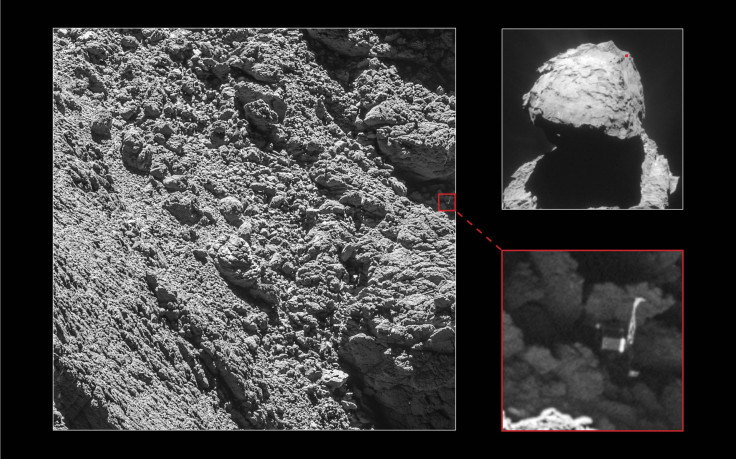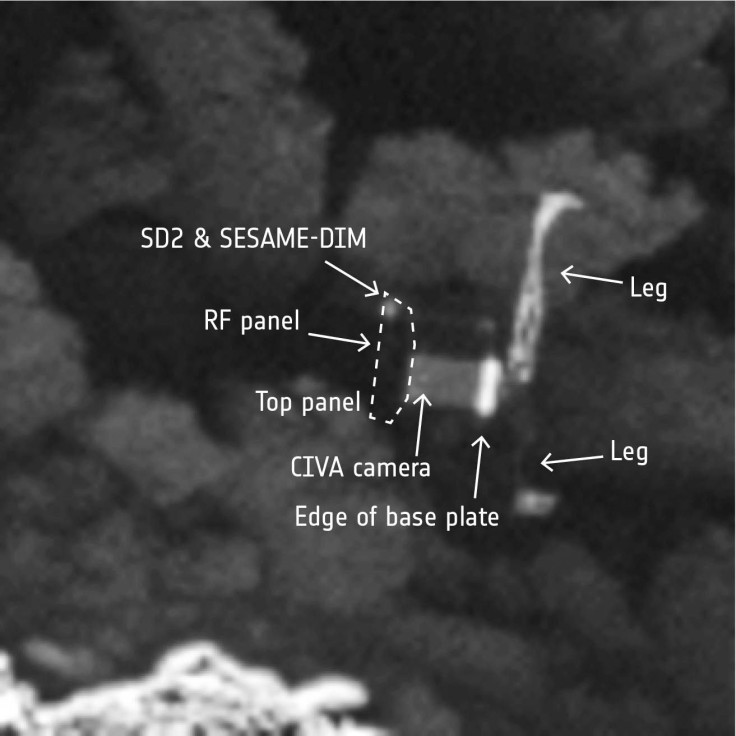Philae: Lost European Space Agency Comet Lander Found Lodged In A Dark Crack On 67P

Philae has been found. The European Space Agency’s (ESA) robotic lander, which became the first human-made object to set foot on a comet in 2014, was discovered by the Rosetta spacecraft’s high-resolution OSIRIS camera tucked away in a dark crack on Comet 67P/Churyumov–Gerasimenko.

The images, taken on Friday, reveal why the lander lost contact after its rough landing. The lander is lodged in a shaded area where it’s not receiving enough sunlight to power its solar panels.
“With only a month left of the Rosetta mission, we are so happy to have finally imaged Philae, and to see it in such amazing detail,” Cecilia Tubiana, a member of the OSIRIS camera team, said in a statement released Monday.
I was so close to #67P, I could even make out @Philae2014's legs and instruments! https://t.co/xBcHlOuE5b pic.twitter.com/valSCdwtZ9
— ESA Rosetta Mission (@ESA_Rosetta) September 5, 2016
Philae created history on Nov. 12, 2014, when it touched down on the surface of a comet. However, the landing did not go entirely without a hitch. It failed to deploy harpoons that would’ve anchored it to the surface, and, as a result, it bounced off toward a dark area on the comet's surface.
It continued to operate on battery power for nearly 60 hours, beaming back invaluable science data, before entering a state of hibernation. Although it “woke up” briefly and contacted Earth through its mothership last year, it has since fallen back into a deep slumber.
In February, scientists at ESA announced that the chances of Philae re-establishing contact were “almost zero,” hinting that it may be time to say goodbye to the comet lander. Then, in July, the ESA switched off the Electrical Support System Processor Unit (ESS) on the Rosetta spacecraft, which is the interface used for communications between Rosetta and the lander.
The discovery of the exact location of Philae’s resting place can now help scientists put the data — collected by the lander during the 60 hours it was active — in context. For instance, the data about the comet’s interior structure and composition gathered by the CONSERT (Comet Nucleus Sounding Experiment by Radio wave Transmission) experiment could not be analyzed properly without knowing Philae’s location on 67P.
“Now that the lander search is finished we feel ready for Rosetta's landing, and look forward to capturing even closer images of Rosetta's touchdown site,” Holger Sierks, principal investigator of the OSIRIS camera, said in the statement.
The mission will conclude on Sept. 30 when Rosetta crash lands on the comet’s surface. During its final descent, the orbiter will conduct critical, up-close observations that may reveal further details of 67P’s interior structure.
© Copyright IBTimes 2025. All rights reserved.





















